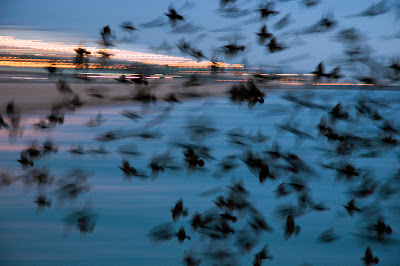 |
| Implying Motion Photography |
Implying motion in a still photograph appears at first as a contradiction; how to give stillness and movement at the same picture; ingenuity can do that and much more. The above image was shot at a children’s park; please have a look at the lady and a boy watching two children are enjoying their ride on swing.The rope of the swing has vanished in the thin air; while those children in the swing are partly visible. The onlookers are standing still and hence clear and well- focused. It is the blur that gives the feel of movement to the swing.
There are different ways for capturing movement in our photographs-some of which we have been already covered in our previous articles–titles and subjects listed below.
 |
| Photo by: James Offer |
- Photograph fast moving subjects using slow shutter speeds.
- Move the camera along with a moving subject to make the subject sharp but register movement in background elements. – ‘Panning’.
- Purposefully move the camera during an exposure. – ‘Painting With Shutter Speed’.
- Zoom in or Zoom out during an exposure. – ‘Zooming’.
In this article we discuss how to make use of blur (generally considered an imperfection) to give a feel of movement to the subjects and make the images more interesting. Yet another technique that can be tried is to Contrast moving subjects to still ones. In a situation where the camera is stationary;lighting conditions are less than ideal; and there are moving as well as stationary elements in the frame; it’s the right scene to try this technique.
 |
| Implying Motion Photography |
The combination of all the three factors allows photographer to ‘imply motion in his photographs’. The result will be a composition in which all the stationary elements are recorded in sharp detail while moving subjects appear blurred.
Typical scenarios that are ideal for this kind of photography are waterfalls, streams, crashing waves, planes, trains and automobiles etc. Simple acts of people like striking a nail; everyday objects like ceiling fans, merry go-round, children playing on seesaw etc. are good subjects.
Wind is a great facilitator; windblown hair of a model, or it blowing through wheat- field or wild flowers, architecture with clouds moving overhead etc. the list is endless and so is the potential for using this technique.
 |
| Photo by: Andree Ludtke |
Successfully capturing the right amount of movement in your shots could accomplish many things, it could communicate mood, can be used to eliminate distracting elements in the scene add interest to the photograph and more.
There is no such thing called technical standards in photography; that can make you successful in profession. Free your minds and look up on blur or distortions as creative tools rather than technical mistakes. Become more intuitive in your pursuit of ideas; never fail to experiment any technique to make final image more interesting.
How to imply motion in photographs using a Tripod
 |
| Photo by: Morbcn |
When our intention is to express a feel of movement through various forms of blurs; think of the following facts. A moving subject appears blurry with slower shutter speeds. The faster the movement of the subject greater the blur for any given shutter speed. Similarly the slower the shutter speed the greater the blur for any given subject speed and vice versa.
Implying Motion in Photography - Step By Step Tutorial
 |
| Photo by: Phil Hilfiker |
- Set up your camera on a stable tripod; or any stable surface will suffice.
- Compose your frame; there should be both stationary and still subjects within it.
- Set your camera to the lowest ISO possible.
- Focus on the most interesting stationary subject in the frame and shift to manual focus.
- Choose shutter priority/ time value as your shooting mode and set the desired shutter speed.
- If the camera’s exposure meter blinks, indicating that the set speed is not possible with current lighting (normally excess light) try using an ND filter or a Polarizing filter. Depending on the lighting conditions; use a darker ND or stack multiple filters.
It is said that great works make great men; then great images naturally make great photographers even.
Related Reading
- How to Photographs Fireworks - Tips for Photographing Fireworks Displays
- How to Capture Motion Blur in Photography - Tips for Photographing Moving Subjects
- How to Get Shallow Depth of Field in Your Digital Photos
- How to Recover Deleted Photos From Camera's Memory Card
- CandleLight Photography - How to Photograph In Candle Light
Post a Comment